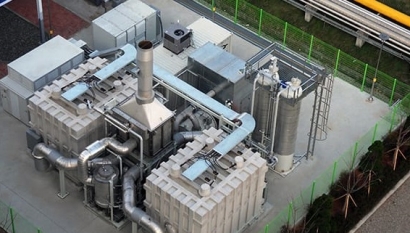Using biogas began with the company’s very first commercial power plant shipment in 2003. That first 250 kW system operated on digester gas at a Kirin Brewery in Japan. A year later the company started the first prototype of today’s 1.4MW SureSource 1500 at the King County Wastewater Treatment plant in Renton, Washington. In subsequent years, the company has deployed over 20 MW of fuel cell systems operating on renewable biogas at wastewater treatment facilities agricultural facilities and breweries in California and around the world, leading up to the recently commissioned 2.8 MW Tulare project and the in-development 1.4 MW San Bernardino project.
FuelCell Energy’s continued focus on innovation led to a series of improvements in the gas cleaning and purification techniques the company uses to execute on-site biogas applications, leading to the best in class solution for clean power generation from this abundant and ever growing renewable resource. Some of the key advances developed through this extensive experience include the following:
- Dual-fuel capability: In the first Kirin brewery application in 2003, the brewery did not make biogas on the weekends, and natural gas was not available. FuelCell Energy developed a feature that allowed its molten carbonate fuel cells to operate on propane during biogas outages. Now all FuelCell on-site biogas projects include a backup fuel capability, with the on-site biogas backed up by a secondary supply of natural gas or directed biogas.
- Fuel-blending capability: At the King County facility, while consistent full power output was desired, the biogas production rate varied through the week. FuelCell Energy developed a feature that allowed its fuel cells to operate on any blend ratio of biogas and natural gas, keeping output at the plants level while biogas availability fluctuated. This fuel blending feature is now standard on FuelCell Energy’s platform and supports any project with varying biogas availability.
- Improved gas cleanup: Biogas has approximately 60 percent of the energy content of natural gas due to dilution with carbon dioxide. Biogas includes impurities such as moisture and high levels of sulfur. The carbon dioxide dilution does not cause a problem for carbonate fuel cells as a result of unique properties of the carbonate electrochemistry, however the gas needs to be dried and the sulfur needs to be removed. Early projects used third-party suppliers for gas treatment systems, which suppliers used a variety of approaches based mostly on internal combustion engine experience. Some of those systems were ineffective or unreliable, and in some cases led to projects not meeting expectations due to fuel contamination. Realizing the need to leverage its own research and development expertise, FuelCell Energy developed in-house an improved, proprietary clean-up system. The first SureSource TreatmentTM system has been operating flawlessly at the City of Riverside since September 2016, and will be a key element of all biogas projects going forward.
- Advanced Gas Monitoring: Sulfur cleanup is very important to fuel processing, and available technologies for continuously measuring sulfur concentration did not have the sensitivity or reliability needed to protect the fuel cell. FuelCell Energy developed a proprietary approach to sulfur detection exponentially more sensitive than anything available on the market. This technology has been operational at Riverside, was recently installed on the Tulare project, and will be a key part of all future projects.
The U.S. Department of Agriculture has previously estimated the potential for electricity generation from biogas in the United States is 4.7 GW, consisting of 0.6 GW wastewater, 2.6 GW landfill, and 1.5 GW agricultural1. The World Biogas Association estimates the global potential for wastewater and landfill gas opportunities to be 40 – 50 times that of the United States, and the agricultural potential more than 200 times.2 Only a fraction of this potential is currently being used for power generation, meaning that biogas methane is being vented or burned in flares, negatively impacting the environment. Widespread application of on-site biogas power production using the advanced technologies developed at FuelCell Energy can eliminate this waste and contribute to global decarbonization objectives.
1 https://www.usda.gov/oce/reports/energy/Biogas_Opportunities_Roadmap_8-1-14.pdf
2 https://www.worldbiogasassociation.org/wp-content/uploads/2019/09/WBA-globalreport-56ppa4_digital-Sept-2019.pdf


